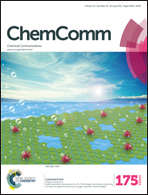Synthesis of pyrrolo[1,2-a]quinolines and ullazines by visible light mediated one- and twofold annulation of N-arylpyrroles with arylalkynes†
Abstract
1-(2-Bromophenyl)-1H-pyrrole and 1-(2,6-dibromophenyl)-1H-pyrrole react in the presence of catalytic amounts of rhodamine 6G (Rh-6G) and N,N-diisopropylethylamine (DIPEA) under blue light irradiation with aromatic alkynes and subsequently cyclize intramolecularly to form pyrrolo[1,2-a]quinoline and ullazines. The reactions proceed at room temperature, avoid transition metal catalysts, and provide the target compounds in one pot in moderate to good yields. Mechanistic investigations suggest that the photo excited Rh-6G is reduced by DIPEA to form the corresponding radical anion Rh-6G˙−, which is again excited by 455 nm light. The excited radical anion of Rh-6G donates an electron to the aryl bromide giving an aryl radical that is trapped by aromatic alkynes. The intermediate vinyl radical cyclizes intramolecularly and yields the product after rearomatization.
![Graphical abstract: Synthesis of pyrrolo[1,2-a]quinolines and ullazines by visible light mediated one- and twofold annulation of N-arylpyrroles with arylalkynes](/en/Image/Get?imageInfo.ImageType=GA&imageInfo.ImageIdentifier.ManuscriptID=C6CC04366F&imageInfo.ImageIdentifier.Year=2016)


 Please wait while we load your content...
Please wait while we load your content...